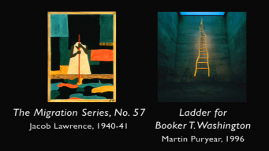Teachers' Domain - Digital Media for the Classroom and Professional Development
User: Preview





Picturing America is a project of the National Endowment for the Humanities, carried out in partnership with the America Library Association, the Institute of Museum and Library Services, and the Office of Head Start.
Funding for the educational resources in this collection was provided by the Institute of Museum and Library Services.
In this video from Picturing America on Screen, students learn about American artists Jacob Lawrence and Martin Puryear.
Inspired by the musical storytelling of West Africa’s griots, Jacob Lawrence employed in The Migration of the Negro Panel no. 57 a painted and written narrative to invoke how African-American families “came up” from the South to settle in cities such as New York, Chicago, Detroit, Cleveland, and Pittsburgh.
Suspended above the floor and anchored by almost undetectable wires, Martin Puryear’s 36-foot Ladder for Booker T. Washington seems to float in space as it rises and abruptly narrows at the top. The artistic metaphor of a ladder not easily climbed dovetails with the contradictions in the legacy of slave-turned-educator Booker T. Washington.
Jacob Lawrence: The Migration Series no. 57, 1940-41 (Document)
Martin Puryear: Ladder for Booker T. Washington, 1996 (Document)
Guide your students in a close reading of the informational texts provided with this video. Download Jacob Lawrence: The Migration Series no. 57, 1940-1941 and Martin Puryear: Ladder for Booker T. Washington, 1996 and make copies for each student.
Begin by having students read the essay silently. Next, read the essay aloud to the class and have students follow along.
Direct students to refer to the text as they answer the questions below.
A Close Reading of "Jacob Lawrence: The Migration Series no. 57, 1940-1941"
A Close Reading of "Martin Puryear: Ladder for Booker T. Washington, 1996"
If students have read both essays, ask them to compare and contrast the ways each artist went about titling his work.
-----Visit the NEH Picturing America website to find more innovative ways to integrate works of American art into your teaching.
DAVID C. DRISKELL (ARTIST AND SCHOLAR): Jacob Lawrence is significant to American art in many ways, first and foremost I think because he is one of the few African-American artists to break the color barrier early on when racism was still with us and full-blown, and perhaps the very first African-American artist to look at the history of the nation and the migration of Black people from the South to the North.
Lawrence’s Migration Series is really all but global in its view of African-American history, that is, the history related to how Black people left the South in large numbers, in the millions, went North in different directions to New York, to New Jersey, to New England, to Chicago, to Detroit, for better opportunities because they thought that the North was the promised land. Importantly in all of this, was Lawrence’s emphasis on the historical question of the work ethic in the Black community. The building of this nation was the labor of Black people.
Panel 57 is really symbolic of the work ethic that Lawrence gave us in the Migration Series, and the woman is consumed by her own bodily motions and actions of working, of providing, the notion that she has no time for herself because she is working for others. She’s got a whole household to feed. It is a major depiction of how struggle was part in parcel of what took place when one went North. He is including so many things in that one composition that really reads the mother, the sister, the aunt, who is really responsible for keeping the family going.
Martin Puryear started experimenting with a form of artistry that seemed very, very foreign to everybody else, all but a minimal approach to sculpture. Could he have done this without the influence of other artists, even, say, a Lawrence preparing the way for him? Um, perhaps so; but I think being a very astute person he saw all that. He talked about the Harlem Renaissance, so he knew what the role was, the progression of it. He had looked at the ancient forms of building. He had looked at Asian art in general, Japan, China. He knew that there was something very special about the craft’s tradition which he wanted to revive in his work.
Martin Puryear created a work in which he singles out an African-American educator, Booker T. Washington, who had this dream of setting up a school for Black people in the South and went down to Alabama and founded Tuskegee Institute. When I see that ladder, I see an unending path to creativity, an unending path to what is possible. By virtue of the fact that the ladder is wide at one end and narrow at the other, it’s a progression of science, it’s a progression of history, it’s a progression of perspective. It narrowly goes so far up, until it’s almost like there’s no end to it. And certainly for me, it’s symbolic of moving from Booker T. Washington through integration, through all the phases of history, to what we don’t know.
 Loading Standards
Loading Standards